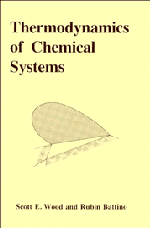Book contents
- Frontmatter
- Contents
- Preface
- Notation
- 1 Introduction
- 2 Temperature, heat, work, energy, and enthalpy
- 3 The second law of thermodynamics: the entropy function
- 4 Gibbs and Helmholtz energy functions and open systems
- 5 Conditions of equilibrium and stability: the phase rule
- 6 Partial molar quantities
- 7 Ideal gases and real gases
- 8 Liquids and solids: reference and standard states
- 9 Thermochemistry
- 10 Phase equilibrium
- 11 Chemical equilibrium
- 12 Equilibria in electrochemical systems
- 13 Surface effects
- 14 Equilibrium conditions in the presence of an external field
- 15 The third law of thermodynamics
- Appendices
- Cited references and selected bibliography
- Subject index
8 - Liquids and solids: reference and standard states
Published online by Cambridge University Press: 28 October 2009
- Frontmatter
- Contents
- Preface
- Notation
- 1 Introduction
- 2 Temperature, heat, work, energy, and enthalpy
- 3 The second law of thermodynamics: the entropy function
- 4 Gibbs and Helmholtz energy functions and open systems
- 5 Conditions of equilibrium and stability: the phase rule
- 6 Partial molar quantities
- 7 Ideal gases and real gases
- 8 Liquids and solids: reference and standard states
- 9 Thermochemistry
- 10 Phase equilibrium
- 11 Chemical equilibrium
- 12 Equilibria in electrochemical systems
- 13 Surface effects
- 14 Equilibrium conditions in the presence of an external field
- 15 The third law of thermodynamics
- Appendices
- Cited references and selected bibliography
- Subject index
Summary
The thermodynamic equations for the Gibbs energy, enthalpy, entropy, and chemical potential of pure liquids and solids, and for liquid and solid solutions, are developed in this chapter. The methods used and the equations developed are identical for both pure liquids and solids, and for liquid and solid solutions; therefore, no distinction between these two states of aggregation is made. The basic concepts are the same as those for gases, but somewhat different methods are used between no single or common equation of state that is applicable to most liquids and solids has so far been developed. The thermodynamic relations for both single-component and multicomponent systems are developed.
The thermodynamic functions have been defined in terms of the energy and the entropy. These, in turn, have been defined in terms of differential quantities. The absolute values of these functions for systems in given states are not known. However, differences in the values of the thermodynamic functions between two states of a system can be determined. We therefore may choose a certain state of a system as a standard state and consider the differences of the thermodynamic functions between any state of a system and the chosen standard state of the system. The choice of the standard state is arbitrary, and any state, physically realizable or not, may be chosen. The nature of the thermodynamic problem, experience, and convention dictate the choice.
- Type
- Chapter
- Information
- Thermodynamics of Chemical Systems , pp. 159 - 208Publisher: Cambridge University PressPrint publication year: 1990



